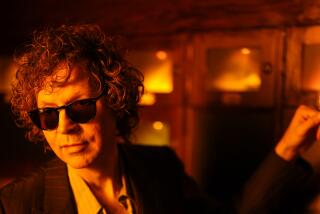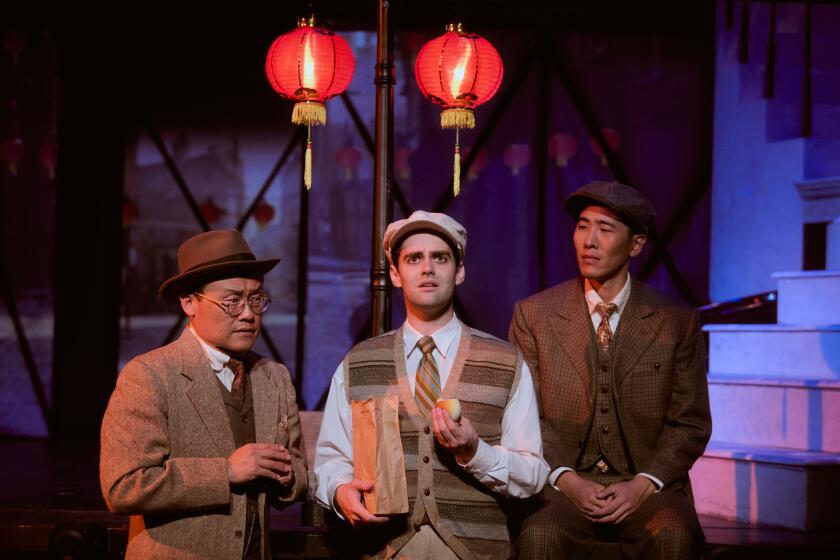ART REVIEW : 10 California Artists ‘Facing the Finish’
Once a staple of museums professing a commitment to the art of our time, substantive exhibitions devoted to an analysis of a specific theme have not been in much evidence in recent years. That may be one contributing reason why “Helter Skelter: L.A. Art in the 1990s,” the sprawling and noisy show that closed this week at the Museum of Contemporary Art, ended up firmly entrenched in the spotlight: Whatever its considerable flaws, the show did make a stab at deciphering the flow of some notable recent art.
It’s hard to think of another major American museum that has lately even attempted as much. Organizing a show around a theme--or, better, recognizing a shared constellation of artistic ideas issuing from a variety of disparate works by an otherwise independent array of artists--poses abundant difficulties.
Those problems are forthrightly acknowledged by the organizers of “Facing the Finish: Some Recent California Art,” a small show that opened Sunday at the Williamson Gallery at Pasadena’s Art Center College of Design, following prior engagements in Santa Barbara and San Francisco. In fact, as if to say a convincing theme show just couldn’t be done, the curators almost threw up their hands in despair.
At the invitation of L.A.’s unaffiliated support group, the Fellows of Contemporary Art, “Facing the Finish” was organized by John Caldwell and Robert Riley, curators at the San Francisco Museum of Modern Art. The 10 artists they selected are based in the state’s three principal cultural centers. Six of them--David Kremers, Rachel Lachowicz, Jorge Pardo, Sarah Seager, Millie Wilson and Christopher Williams--work in Los Angeles. Three--Nayland Blake, Jerome Caja and Jim Campbell--work in San Francisco. The 10th--James Luna--works in San Diego.
Within obvious limits, this distribution is a pretty accurate reflection of the relative artistic liveliness within the state. And, blessedly, the curators have dismissed regionalism as a thematic hook for the show. Despite the artists’ shared residence in California, this is not an exhibition that means to flog a provincial claim that the Golden State is somehow its subject.
Unexpectedly, however, the demographics turn out to be significant for the overall impact of the show, because, now that it’s roosting in Los Angeles, the overwhelming majority of the work will be familiar to any who visit the city’s galleries with any regularity. Pardo’s reconfigured furniture and his abstract paintings based on layouts in mail-order catalogues were shown last year at the now-defunct Luhring Augustine Hetzler Gallery. Millie Wilson’s selections from “The Museum of Lesbian Dreams,” in which the typological analysis common to art and anthropological museums collides with the modern practice of scientific typing of human behavior, were seen last year at Meyers/Bloom Gallery. “Angola to Vietnam,” Williams’ photographic dissertation on the ways in which political life is relentlessly aestheticized, has been shown several times in a variety of venues since it was made in 1989.
Lachowicz’s macho-minimalist sculptures, devilishly cast from slabs of jungle-red lipstick rather than steel or aluminum; Seager’s ethereally minimalist sculptures, assembled from fluorescent tubes or painted an industrial white; Kremers’ chemically decaying paintings, made from 30-year-old pigments whose origin roughly coincides with the moment of the widely touted “death of painting”--almost all the work by the L.A.-based artists has found fairly recent exhibition in Southern California galleries and museums.
So have Nayland Blake’s intimate, Sony Watchman video-sculpture, “Still Life,” and his haunting shrine to the infamously foul-mouthed marionette, Madame--stilled puppet of the late comedian Wayland Flowers. Of the four artists not based in L.A., Blake is the only one with an established national reputation, and both these sculptures have been seen here before.
That leaves just three artists whose work has rarely--or never--been encountered here. Luna’s installation, “Wake/Velorio (He’s Resting Now)” melds American Indian tribal ritual, past and present, in a funereal scene that means to commemorate the disappearance of an entire culture; portions are acutely observed, but the whole doesn’t quite match up to the scale of its ambitions. Campbell’s two video installations, which make use of live and computer-delayed image technology, are playfully engaging; but, compared to the obvious precedent of Bruce Nauman’s live-taped video work, they’re conceptually thin.
Finally, Caja’s host of quirky, decoratively embellished little paintings claim an eccentric charm both witty and sobering. Painting with such odd materials as eyeliner, nail polish and white-out on everything from ashtrays and bottle caps to clipped toenails, he creates a claustrophobic world of fragile lives and broken emotions in which the joy surrounding the birth of an egg can be dampened by the simultaneous birth of a frying pan. Caja is something of an off-center discovery.
Caja’s paintings, which haven’t been seen here before, backhandedly demonstrate a principal weakness of the show. There’s nothing wrong with including well-known works of art--even by younger artists--in an exhibition such as this, and “Facing the Finish” may even have been beneficial in carrying new information to the other stops on its brief tour. Yet, it doesn’t have that edge in Los Angeles, since more than two-thirds of the show has been seen here within the last year or so.
Ironically, this familiarity ups the ante for the thematic raison d’etre of the show. You’re primed for engagement, because the move from gallery into museum and from individual consideration to a reverberative group context ought to provide some unexpected enlightenment for the art. But that never really happens here.
Something vague and indistinct does get said about a theme. The finish in “Facing the Finish” isn’t clearly identified in either the show or the catalogue, but it is alluded to. Neither apocalyptic nor millenarian, the artists are said to have looked at the finish of “particular styles and movements in art, finding new meaning in the reconsideration of traditional forms, or the end of social or political structures, and then asked themselves what comes next.” The curators don’t use the P-word, but it certainly sounds like Postmodernism is what they’re getting at.
And, in fact, what these 10 artists actually have in common is simply that their artistic sensibilities were chiefly formed in the 1980s, the moment in which a sense of Modernist exhaustion became widespread. That fact might be telling for their work, but in this exhibition it doesn’t make for much of a theme.
Williamson Gallery, Art Center College of Design, 1700 Lida St., Pasadena, (818) 584-5144, through June 14. Closed Monday.
More to Read
The biggest entertainment stories
Get our big stories about Hollywood, film, television, music, arts, culture and more right in your inbox as soon as they publish.
You may occasionally receive promotional content from the Los Angeles Times.







